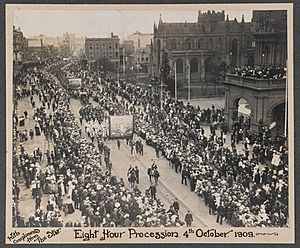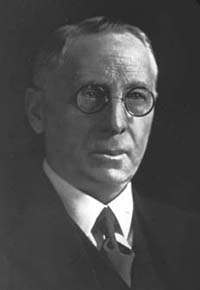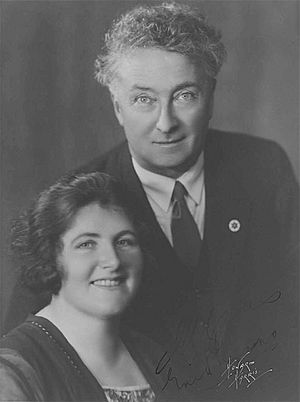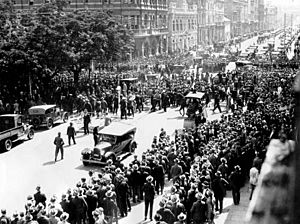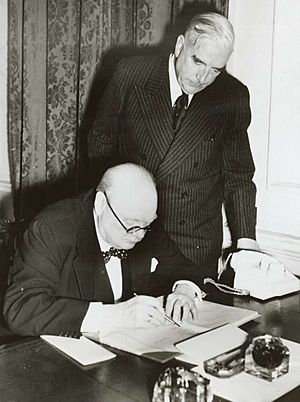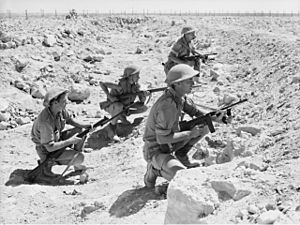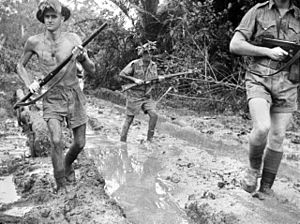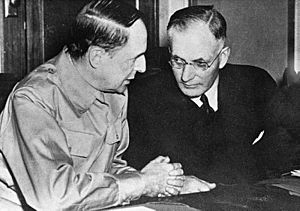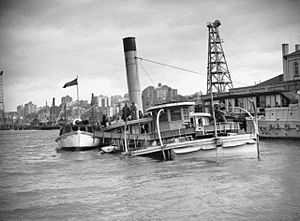History of Australia (1901–1945) facts for kids
The history of Australia from 1901 to 1945 covers a very important time for the young nation. It begins when the six separate colonies joined together to form the Commonwealth of Australia. This new country then faced big challenges, including fighting alongside Britain in the First World War, struggling through the worldwide Great Depression, and then joining the Second World War against Nazi Germany and Imperial Japan. During the Second World War, Japanese forces even attacked Australian cities.
Contents
Becoming a Nation: Federation
Before 1901, Australia was made up of six British colonies: New South Wales, Tasmania, South Australia, Western Australia, Victoria, and Queensland. These colonies had been set up after the first British ships arrived in Sydney in 1788.
After almost 20 years of talks, all six colonies agreed to join together. The British Parliament also approved this plan in 1900. So, on 1 January 1901, the six colonies officially became one country called the Commonwealth of Australia.
Melbourne was the temporary capital city while a new capital, Canberra, was being built. The future King George V opened Australia's first Parliament of Australia in Melbourne on 9 May 1901. Later, in May 1927, the new Parliament House in Canberra was opened. Australia slowly gained more independence from Britain, especially after 1942.
Early Years of the New Nation
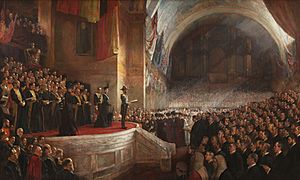
The Commonwealth of Australia officially began on 1 January 1901. The first national elections were held in March 1901. Edmund Barton became Australia's first Prime Minister. He promised to create a national court, improve public services, and introduce old age pensions. He also wanted laws to protect "White Australia" by limiting immigration from Asia.
The Australian Labor Party (ALP) was formed in the 1890s and quickly gained support. It aimed to improve conditions for workers. In 1904, Chris Watson became the first Labor Prime Minister. This led to other political groups joining forces to form the Commonwealth Liberal Party in 1909, which later became the Liberal Party of Australia. The Country Party was also formed in the 1910s to represent farmers.

One of the first laws passed by the new Australian Parliament was the Immigration Restriction Act 1901. This law aimed to limit immigration from Asia, especially China. It allowed a "dictation test" in any European language, which was used to stop non-white immigrants from entering Australia. Many Australians supported this law, fearing a large number of non-British migrants. Some politicians, like Bruce Smith, spoke about avoiding offense to educated people from other nations. However, the law remained a key part of Australia's immigration rules until the 1950s.
Before 1901, Australian soldiers had already fought alongside British forces in the Second Boer War. After this, Australians felt they needed to protect themselves more. The visit of the US Navy's "Great White Fleet" in 1908 showed the importance of having an Australian navy. By 1913, Australia had its own battlecruiser, the Australia, leading the new Royal Australian Navy.
Working conditions for many Australians in the early 1900s were described as "frugal comfort." A special court was set up to handle worker disagreements and set fair wages. In 1907, the idea of a "basic wage" was recognized, and in 1908, the government started an old age pension scheme. Australia became known for trying out new social ideas.
Australia in the First World War
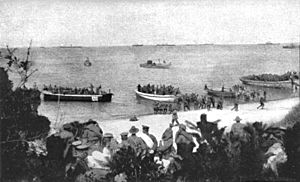
Australia sent thousands of troops to fight for Britain in the First World War from 1914 to 1918. Many Australians lost their lives at Gallipoli in Turkey, and even more in France. These battles, both victories and losses, became a very important part of Australia's national identity. By the end of the war, over 60,000 Australians had died, and 160,000 were wounded.
Australia remembers its war dead every year on ANZAC Day, 25 April. This date marks the first landings at Gallipoli in 1915. At Gallipoli, ordinary soldiers showed great bravery. In France, where many more Australians died, the huge guns of modern war showed how little individual soldiers mattered.
After being pulled out of Gallipoli in late 1915, the Australian Imperial Forces (AIF) were sent to France to fight on the Western Front. Their first major battle there, at Fromelles in July 1916, was the most costly single day in Australian military history, with 5,533 killed or wounded in just 24 hours.
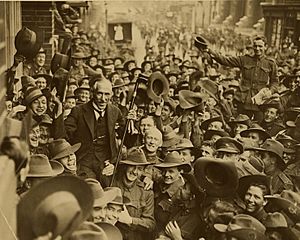
Two votes were held in Australia in 1916 and 1917 to decide if men should be forced to join the army (conscription). Both votes failed, so Australia's army remained made up of volunteers. Prime Minister Billy Hughes strongly supported conscription and was even expelled from the Labor Party because of it. He then joined with other politicians to form the Nationalist Party.
In 1919, Prime Minister Billy Hughes went to the peace conference in Paris after the war. He signed the Treaty of Versailles for Australia, which was the first time Australia had signed an international treaty on its own. Hughes demanded that Germany pay a lot of money for the war. He famously told US President Woodrow Wilson, "I speak for 60,000 [Australian] dead," when Wilson questioned Australia's demands.
Hughes also pushed for Australia to have its own voice in the new League of Nations. He was worried about Japan's growing power in the Pacific. Australia gained control over former German territories in New Guinea as a "mandate" (a special type of control) from the League of Nations. Many believe Hughes's success in getting this control was very important, as it helped prevent a Japanese invasion of Australia later in the Second World War.
Between the Wars: The 1920s and 1930s
The Roaring Twenties
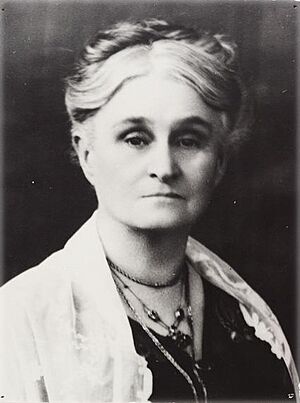
After World War I, Australia faced new challenges. Around 12,000 Australians died from the Spanish flu pandemic in 1919, likely brought home by returning soldiers.
The 1920s in Australia saw many worker strikes and disagreements. In response, the Australian Council of Trade Unions (ACTU) was formed in 1927 to protect workers' rights.
New technologies changed life in Australia. Sailing ships were replaced by steamships, and improvements in trains and cars made travel easier. In 1918, there were 50,000 cars in Australia; by 1929, there were 500,000! The Royal Flying Doctor Service, the world's first air ambulance, was started in 1928 by Reverend John Flynn. Brave pilot Charles Kingsford Smith became famous for his record-breaking flights, including flying across the Pacific Ocean in 1928.
Australia, like many countries, borrowed a lot of money from overseas in the 1920s to fund big projects. This made the country very vulnerable when the world economy started to slow down.
The Great Depression
Australia relied heavily on selling products like wheat and wool overseas. So, when the Great Depression hit in the 1930s, it caused huge problems, leading to high unemployment and poverty. The Labor Party won the 1929 election, but they struggled to deal with the crisis. The party split, and in 1932, a new conservative party, the United Australia Party (UAP), led by Joseph Lyons, took power.

Australia's economy was already facing problems before the Wall Street Crash of 1929 in the USA. As the economy slowed in 1927, factories made less, and unemployment rose. Different ideas were suggested to fix the crisis. Some wanted to cut government spending and wages, while others wanted to print more money or even refuse to pay overseas debts.
The "Premier's Plan," agreed to in June 1931, involved cutting government spending by 20% and reducing bank interest rates. However, the Premier of New South Wales, Jack Lang, refused to follow the plan and was later dismissed by the state Governor.
In May 1931, the United Australia Party was formed, and in December 1931, Joseph Lyons became Prime Minister. His government helped Australia recover from the Depression and stayed in power until the start of World War II. Lyons believed in balancing budgets and lowering costs for businesses. During this time, manufacturing grew, and Australia became less reliant on farming.
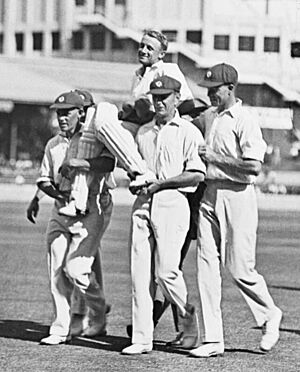
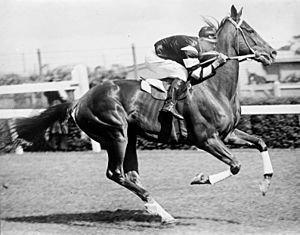
The Depression was a tough time, but sporting heroes helped lift spirits. In 1930, 21-year-old Don Bradman scored a world record 452 runs in a cricket match, bringing joy to many. The famous racehorse Phar Lap also dominated racing from 1929 to 1931, winning many races, including the 1930 Melbourne Cup. His sudden death in the US in 1932 shocked Australians.
Australia in the Second World War
Preparing for War

As Nazi Germany grew stronger in Europe and Japan became more aggressive in Asia, defence became a bigger concern for Australia. Prime Minister Lyons increased the defence budget. Australia's defence plan relied on Britain's naval base in Singapore and the Royal Navy. Most defence spending went to the Royal Australian Navy (RAN), which was the best-equipped service in 1939.
However, some, like Labor leader John Curtin, argued that Australia needed to be more self-reliant and build up its own army and air force. Prime Minister Lyons died in April 1939, and Robert Menzies became the new leader. Menzies, worried about Japan, set up independent embassies in Tokyo and Washington to get direct information.
War Begins
On 3 September 1939, Prime Minister Robert Menzies announced on the radio that Australia was at war:
My fellow Australians. It is my melancholy duty to inform you, officially, that, in consequence of the persistence by Germany in her invasion of Poland, Great Britain has declared war upon her, and that, as a result, Australia is also at war.
This began Australia's involvement in the six-year global conflict. Australians fought in many different places, from stopping Hitler's tanks in Tobruk to pushing back the Japanese army in New Guinea. Australian bombers flew over Europe, and naval battles took place in the Mediterranean. Japanese mini-submarines even attacked Sydney Harbour, and Darwin suffered devastating air raids.
A volunteer army, the 2nd Australian Imperial Force, was formed for service overseas, and a citizen militia was organized for local defence. In January 1941, Menzies flew to Britain to discuss the weak defenses at Singapore. When he returned, with Japan threatening and Australian soldiers struggling in Greece and Crete, Menzies tried to form a War Cabinet with the Labor Party. He failed and resigned. John Curtin became Prime Minister. Eight weeks later, Japan attacked Pearl Harbor.
From 1940 to 1941, Australian forces fought bravely in the Middle East, including the Siege of Tobruk. A group of 14,000 Australian soldiers was surrounded in Tobruk, Libya by German and Italian forces. The Germans called them "rats," but the soldiers proudly adopted the name "The Rats of Tobruk". Their defense of Tobruk was vital and boosted morale for the British Commonwealth.
When Japan attacked Pearl Harbor on 8 December 1941, Australia was not ready. Prime Minister Curtin made a historic announcement, stating that Australia would now look to America for help, not just Britain.
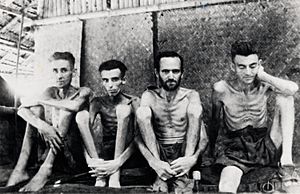
British Malaya quickly fell to the Japanese, shocking Australia. Many Australian soldiers became prisoners of war when Singapore surrendered on 15 February 1942. Curtin predicted that the "battle for Australia" would follow. On 19 February, Darwin was bombed, the first time Australia had been attacked by an enemy. Over the next 19 months, Australia was attacked by air almost 100 times.
Australian soldiers captured by the Japanese suffered terribly. Many died from ill-treatment and harsh conditions, especially while building the Burma-Thailand Railway. The Sandakan Death March in 1944, where 2,000 Australian and British prisoners died, was the worst war crime against Australians.
US President Franklin D. Roosevelt ordered General Douglas MacArthur to plan a Pacific defense with Australia. Curtin agreed to place Australian forces under MacArthur's command. MacArthur moved his headquarters to Melbourne in March 1942, and American troops began arriving in Australia.

In May 1942, the US Navy fought the Japanese in the Battle of the Coral Sea, stopping their plan to invade Port Moresby in New Guinea. In June, the Battle of Midway severely damaged the Japanese navy. The Japanese then launched a land attack on Port Moresby. Between July and November 1942, Australian forces bravely pushed back the Japanese along the Kokoda Track. The Battle of Milne Bay in August 1942 was the first time Allied land forces defeated the Japanese.
In North Africa, Australia's 9th Division played a key role in the Second Battle of El Alamein in late 1942, which turned the tide of the war in North Africa.
The Battle of Buna-Gona from November 1942 to January 1943 saw Australian and US forces attack Japanese strongholds in New Guinea. The fighting was very tough, with many casualties due to disease, difficult land, and strong Japanese defenses. This battle set the pattern for the rest of the New Guinea Campaign, where bitter fighting continued until Japan surrendered in 1945.
Prime Minister Curtin died weeks before the war ended and was replaced by Ben Chifley. By the end of the war, almost 1 million Australian men and women had served in the armed forces. Over 39,700 were killed or died as prisoners of war, with about 8,000 dying as prisoners of the Japanese.
The Home Front
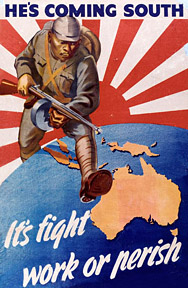
World War II greatly changed the Australian economy. Government spending on the war reached 37% of the country's total production by 1943-44.
The Curtin Labor government, formed in October 1941, made big changes to Australian life. Fuel, clothing, and some food were rationed. Christmas holidays were shortened, and public transport was reduced. From December 1941, the government moved all women and children out of Darwin and northern Australia. Over 10,000 refugees also arrived from Southeast Asia as Japan advanced. A new office was set up to organize Australians to meet all defence needs.
Manufacturing grew a lot because of the war. In 1939, only three Australian companies made machine tools, but by 1943, there were over a hundred. The Royal Australian Air Force (RAAF) became the fourth largest Allied air force by 1945. Australia even designed and built its own fighter plane, the Boomerang, in just four months in 1942, showing how desperate the situation was.
Australia also created a large female workforce for war production. The number of women working in factories rose from 171,000 in 1939 to 286,000 in 1944. In 1943, Enid Lyons became the first woman elected to the House of Representatives, and Dorothy Tangney became the first woman elected to the Senate.
Becoming Fully Independent
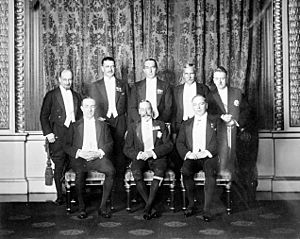
Australia slowly gained full independence from the UK. On 1 January 1901, the British Parliament passed a law allowing the six Australian colonies to govern themselves as the Commonwealth of Australia. This made Australia a "dominion" of the British Empire.
In 1931, the British Parliament passed the Statute of Westminster. This law stopped Britain from making laws for its dominions. It made official what was decided at the 1926 Imperial Conference, which said that dominions were "autonomous Communities within the British Empire, equal in status, in no way subordinate one to another."
Australia did not officially accept the Statute of Westminster until 1942, but it was backdated to 1939. This was because Australians were more focused on the crisis of World War II than on changing their relationship with Britain.
The final step to full independence was the passing of the Australia Act 1986 in the UK. This Act removed Britain's right to make laws for Australia and ended any British role in the government of Australian states. It also stopped appeals from Australian courts to the British Privy Council in London. Most importantly, it gave Australia full control over all its own constitutional documents.
Images for kids
See also
- History of Australia since 1945
- History of broadcasting in Australia


